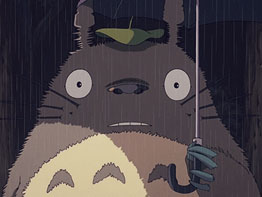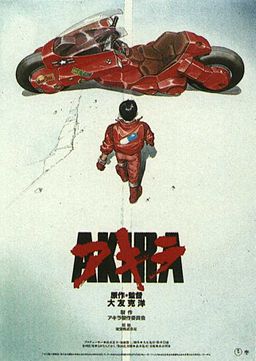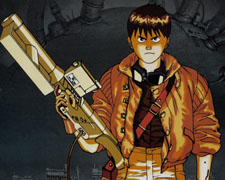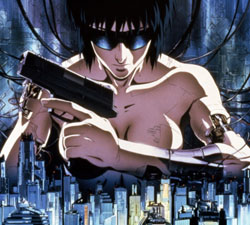Continuing my list of “Top Ten” favorite anime features with three from the modern masters of anime, Hayao Miyazaki, Katsuhiro Otomo and Mamoru Oshii.
6. My Neighbor Totoro. Tonari no Totoro. Produced by Studio Ghibli. Directed by Hayao Miyazaki. 86 minutes. April 16, 1988.
 As I said, I thought that Laputa is a perfect boys’ adventure film, which is what I like. So when I first read in the anime magazines that Miyazaki’s next feature would be a gentle young girls’ fantasy, my reaction was, “Oh, well. Little girls deserve a movie, too. I’m sure that it will be excellent, even if I won’t care for it.”
As I said, I thought that Laputa is a perfect boys’ adventure film, which is what I like. So when I first read in the anime magazines that Miyazaki’s next feature would be a gentle young girls’ fantasy, my reaction was, “Oh, well. Little girls deserve a movie, too. I’m sure that it will be excellent, even if I won’t care for it.”
When I saw My Neighbor Totoro, I was blown away. Again. It was then that I decided that Miyazaki is God, incapable of making a film that I don’t love even when it features a subject that normally bores me to tears.
The setting is the Japanese countryside shortly after World War II. (Wikipedia says 1958.) University professor Tatsuo Kusakabe has moved to a rural area with his daughters Satsuki (11 years old) and Mei (4 years old), to be near his wife/their mother who is recovering in a tuberculosis sanatorium. The movie is told from the girls’ standpoint, focusing alternately on their joyful adaptation to rural life, Satsuki’s making friends with neighborhood children and starting in the local school, Mei’s discovery of the fantasy nature characters (which she accepts as natural since she’s only 4 years old), and then Satsuki’s seeing them, too. The dramatic climax is the children’s mistaking their mother’s delayed release from the hospital to believe that she has gotten worse and is dying; and while their father and the audience know the truth, the children’s anguish and terror are heartfelt and convincingly portrayed – as is the potential danger that 4-year-old Mei, who runs away to find the hospital, may become lost, injured, or drown in a rice paddy. The happy ending is delightful. This is another movie that I have probably seen a dozen times, and I am ready to see it again.
 I am cynically amused by its reviews. Wikipedia reports that “The 1993 translation was not as well received as the 2006 translation”, but the article makes it clear that the 1993 reviews (of its American theatrical release by Troma Films/50th Street Films, that May) were of the film itself, not its 1987 dialogue translation by Carl Macek. “[A]dequate television technical craft”, “[a] vapid storyline”, and “a disorienting combination of cultures that produces a nowhere land more confused than fascinating” are not critiques of the quality of the dialogue, but of the basic plot and of the animation. Miyazaki demanded that the film itself not be altered in any way from the Japanese original version. When My Neighbor Totoro was rereleased (with a new translation and dubbing) by Walt Disney Home Video in March 2006, the same film was hailed as “beguiles from beginning to end”, and has since placed on one “The 100 Best Films Of World Cinema” list; on another list as #3 of the greatest animated films of all time; and on practically every anime fan’s list of the Top Ten anime features. The difference: the film critics’ perception of Troma vs. the Disney name. Also, Hayao Miyazaki was much more prestigious in America by 2006 than in 1993.
I am cynically amused by its reviews. Wikipedia reports that “The 1993 translation was not as well received as the 2006 translation”, but the article makes it clear that the 1993 reviews (of its American theatrical release by Troma Films/50th Street Films, that May) were of the film itself, not its 1987 dialogue translation by Carl Macek. “[A]dequate television technical craft”, “[a] vapid storyline”, and “a disorienting combination of cultures that produces a nowhere land more confused than fascinating” are not critiques of the quality of the dialogue, but of the basic plot and of the animation. Miyazaki demanded that the film itself not be altered in any way from the Japanese original version. When My Neighbor Totoro was rereleased (with a new translation and dubbing) by Walt Disney Home Video in March 2006, the same film was hailed as “beguiles from beginning to end”, and has since placed on one “The 100 Best Films Of World Cinema” list; on another list as #3 of the greatest animated films of all time; and on practically every anime fan’s list of the Top Ten anime features. The difference: the film critics’ perception of Troma vs. the Disney name. Also, Hayao Miyazaki was much more prestigious in America by 2006 than in 1993.
One of Wikipedia’s statements is incorrect, though. When Mei meets the giant totoro, it “identifies itself by a series of roars that she interprets as ‘Totoro’.” No; what Mei says is that she recognizes it (or “him”) as the “totoro” from her picture book. One of the many summaries of the film clarifies that this is Mei’s mispronunciation of “troll”. This could be a reference to Miyazaki’s earlier visit to Sweden when he tried and failed to make an animated adaptation of Astrid Lindgren’s Pippi Longstocking, since trolls are popular in Scandinavian children’s literature and picture books. Much of Miyazaki’s reference art from that visit ended up in his Kiki’s Delivery Service.
7. Akira. Produced by Tokyo Movie Shinsha. Directed by Katsuhiro Otomo. 124 minutes. July 16, l988.
 I have been a science fiction fan since I was nine years old, so how could I not like Akira? Unlike most of cinematic science fiction, Akira presents an original, complex and plausible picture of the future, mixed together with a gripping action story.
I have been a science fiction fan since I was nine years old, so how could I not like Akira? Unlike most of cinematic science fiction, Akira presents an original, complex and plausible picture of the future, mixed together with a gripping action story.
One of the reasons that I first liked it so much was that I could see the inaccuracies in most early descriptions of its plot. The story begins on July 16, 1988 (an ingroup reference to the movie’s release date), when Tokyo is destroyed by a nuclear-type explosion. The source of the explosion is unknown, resulting in Cold War paranoia leading to a brief World War III. This was the source of early summaries saying that Tokyo was destroyed “by a nuclear attack”, or that it was destroyed “in World War III”.
The movie jumps ahead to 2019. What happened to the rest of the world in the war is never told. Tokyo has been completely rebuilt as a glittery Neo-Tokyo metropolis, but it has a dark underside – utopia masking a dystopia. The government is run by an Executive Council of effete bureaucrats, completely out of touch with the people. (There is no mention of the Emperor. Reading between the lines, the entire imperial family must have been killed in the 1988 destruction.) There is a powerful underground revolutionary organization, implying that, while most people are satisfied with the material prosperity of the status quo, the government is not really democratic and those who are dissatisfied must resort to illegal means to protest.
The action starts by focusing on a juvenile delinquent biker gang run by Kaneda. The gang’s youngest member is Tetsuo, who is treated by Kaneda as a kid brother. Tetsuo enjoys Kaneda’s big-brother role-model guidance, but resents his condescension. Kaneda’s bikers are roaring through Neo-Tokyo in gang warfare against the rival Clowns when Tetsuo crashes into a blue-skinned figure, apparently a boy but wrinkled like an old man, who suddenly appears right in front of him. Before Kaneda’s gang (the Capsules) can react, they are all captured by soldiers led by the Colonel and another blue-skinned boy, whose goal is the first blue-skinned boy (Takashi). They prepare to “take him home”, and turn the Capsules over to the police. At the urging of an accompanying scientist (the Doctor), they take Tetsuo with them.
 The audience gradually learns that the Japanese government has long had a top-secret military project to develop a cadre of children with powerful psychic powers. The remnants of this government project in 2019 are the three blue-skinned “children” (Masaru the leader, Takashi, and Kyoko), supervised by the Doctor and under their army guard commanded by the Colonel, plus Tetsuo who has just been identified by the Doctor as a potential esper. Kaneda, at the police headquarters, meets Kei, a teenage girl who is an active revolutionary. Kaneda gets the Capsules and Kei thrown out as essentially harmless punks, but once freed, he is determined to free Tetsuo from wherever the military has taken him. Before that happens, the project’s experiments upon Tetsuo have awakened his psychic powers. He goes power-mad and escapes, taking revenge on not only the military but the Capsules who patronized him. When he kills one of them, Kaneda becomes his enemy to protect and avenge the rest of the Capsules, in parallel with the Colonel who wants to kill Tetsuo who has become too powerful to be controlled.
The audience gradually learns that the Japanese government has long had a top-secret military project to develop a cadre of children with powerful psychic powers. The remnants of this government project in 2019 are the three blue-skinned “children” (Masaru the leader, Takashi, and Kyoko), supervised by the Doctor and under their army guard commanded by the Colonel, plus Tetsuo who has just been identified by the Doctor as a potential esper. Kaneda, at the police headquarters, meets Kei, a teenage girl who is an active revolutionary. Kaneda gets the Capsules and Kei thrown out as essentially harmless punks, but once freed, he is determined to free Tetsuo from wherever the military has taken him. Before that happens, the project’s experiments upon Tetsuo have awakened his psychic powers. He goes power-mad and escapes, taking revenge on not only the military but the Capsules who patronized him. When he kills one of them, Kaneda becomes his enemy to protect and avenge the rest of the Capsules, in parallel with the Colonel who wants to kill Tetsuo who has become too powerful to be controlled.
Akira presents much more: the blue-skinned children’s attempt to neutralize Tetsuo; the vocational school that basically contains but ignores “troublemakers” like the Capsules; the scheming politician Nezu’s plot to manipulate the government; the Colonel’s military coup d’etat to save Neo-Tokyo before it is destroyed again; the revelation that the 1988 destruction of Tokyo was caused by the uncontrolled psychic energy of Akira, the most powerful child in the secret program; and the final confrontation with Tetsuo, the “new Akira”, in the Stadium under construction for the 2020 Olympics. The movie has a rich and complex plot, and it all holds together beautifully. One of its final ironies is that Kaneda, the main protagonist, does not really know what just happened – nor does he care. All that he cares about is that his gang has been avenged, the menace of Tetsuo has been ended, and he’s got the girl. I would say that the audience has gotten the complete story, except for too many reviews that show that much of it was over their heads. Well, I like it! I can see it over and over and still find more details.
Oh, did I mention the great “tonalities” by the Geinoh Yamashiro-gumi? I special-ordered the Original Soundtrack CD almost as soon as I heard it. It became one of the first anime-music CDs to be licensed in America.
It should be pointed out that Akira the movie is little more than the first half of the comic-art novel by Katsuhiro Otomo. When the manga serialization began in 1982, it was so popular that there was a huge demand for an animated feature; before the conclusion had been written, much less published. Otomo refused to relinquish control of it, and he was made the director of the film, to writie a special ending for it. (I suspect that the film’s financiers intended for Otomo to be only a figurehead director, but his direction was so superb that he immediately began getting offers to direct other films, including TV commercials. Since then, Otomo has been primarily an animation and live-action director, and only secondarily a manga author-artist.) After completing Akira the movie, he returned to its manga serialization, extending the story and changing the ending considerably.
8. Ghost in the Shell. Ghost in the Shell: Kōkaku Kidōkai. Produced by Production I.G. Directed by Mamoru Oshii. 82 minutes. November 18, 1995.
 Ghost in the Shell’s author, Masamune Shirow, was one of the first manga superstars in America. Ghost in the Shell, his manga magnum opus, was serialized in Japan in 1989 to 1990, and published in book form in 1991. The American translation was serialized by Dark Horse Comics from March to October 1995, creating a demand for the animated movie from American s-f, comics, and anime-manga fans – there was already a demand in Japan. The Japanese animated feature, then in production by the new Production I.G studio, got additional production money from Manga Entertainment in exchange for the American home video rights. The result was an excellent adult s-f story, and a critical hit on both its Japanese theatrical release and its American limited theatrical and general home-video release.
Ghost in the Shell’s author, Masamune Shirow, was one of the first manga superstars in America. Ghost in the Shell, his manga magnum opus, was serialized in Japan in 1989 to 1990, and published in book form in 1991. The American translation was serialized by Dark Horse Comics from March to October 1995, creating a demand for the animated movie from American s-f, comics, and anime-manga fans – there was already a demand in Japan. The Japanese animated feature, then in production by the new Production I.G studio, got additional production money from Manga Entertainment in exchange for the American home video rights. The result was an excellent adult s-f story, and a critical hit on both its Japanese theatrical release and its American limited theatrical and general home-video release.
In 2029, civilization has grown considerably in a “Blade Runner” manner, mixing the old with the new and interconnecting everything electronically, with individual human brains able to plug directly into the worldwide network. There is also an increased use of cybernetics, with people replacing parts of their bodies with superior artificial versions. The setting is Tokyo, based on 1990s Hong Kong.
The Japanese government’s Public Security Section 9, headed by elderly Daisuke Aramaki, is assigned to track down and capture an elusive super-hacker known as the Puppet Master. Section 9’s active team is led by Major Motoko Nusanagi, a woman who has had so much of herself replaced by cyborg parts that she is almost half-machine. Her men, principally her main assistant Batou, have fewer or no cyborg parts in their bodies.
 The team at first suspects a garbageman and his associate who have the mechanical plugs that enable them to connect into the global electronic network. But they discover that the men are innocent dupes of the real Puppet Master, who has programmed their brains with false memories. About this time, they are led to a female robot body that has apparently come to life on its own, but been destroyed in an accident. As Section 9 begins to investigate, Public Security’s more powerful Section 6 tries to take the case away from them, claiming that the robot body was its failed attempt to trap the Puppet Master’s mind inside it. Kusanagi suspects that the trap did work, and sends her mind into the body. Before Section 9 can discover more, Section 6 physically takes the body away from them. Aramaki suspects that the body and its Project 2501 lead to illegal developments by the Ministry of Foreign Affairs, and that Section 6 has been ordered to destroy the body and the Puppet Master before those developments are revealed. Batou and Section 9’s team go after the body to rescue Major Kusanagi. Inside the body, Kusanagi learns that the Puppet Master is not human, but is an extremely advanced AI program developed by Section 6 to spy on the public, which has developed self-awareness and now wants a body of its own, plus “political asylum”.
The team at first suspects a garbageman and his associate who have the mechanical plugs that enable them to connect into the global electronic network. But they discover that the men are innocent dupes of the real Puppet Master, who has programmed their brains with false memories. About this time, they are led to a female robot body that has apparently come to life on its own, but been destroyed in an accident. As Section 9 begins to investigate, Public Security’s more powerful Section 6 tries to take the case away from them, claiming that the robot body was its failed attempt to trap the Puppet Master’s mind inside it. Kusanagi suspects that the trap did work, and sends her mind into the body. Before Section 9 can discover more, Section 6 physically takes the body away from them. Aramaki suspects that the body and its Project 2501 lead to illegal developments by the Ministry of Foreign Affairs, and that Section 6 has been ordered to destroy the body and the Puppet Master before those developments are revealed. Batou and Section 9’s team go after the body to rescue Major Kusanagi. Inside the body, Kusanagi learns that the Puppet Master is not human, but is an extremely advanced AI program developed by Section 6 to spy on the public, which has developed self-awareness and now wants a body of its own, plus “political asylum”.
Ghost in the Shell brings up valid points that are not usually addressed in cinematic predictions of the future. At what point are Artificial Intelligences independent beings? How far can the human body be enhanced by cybernetics? How far can individual humans be plugged into a global electronic network, and how much danger is there of “the average man” being taken over and controlled by false memories?? Major Kusanagi, a woman now almost 50% machine, worries about what sexuality she may have left. How realistic is the depicted 2029? The movie is a thought-provoking questioning of the future at the same time that it is a tense, fast-paced politico-criminal thriller. This is another anime feature that is so dense that it can be watched many times, with something new to discover each time.
Ghost in the Shell is an acknowledged influence on the Wachowski Brothers in their development of The Matrix and its sequels. Ghost in the Shell has had its own theatrical and TV series sequels.
NEXT WEEK: I continue the survey of my “Top Ten” anime features.
NOTE: I covered the last two years of Ron Diamond’s annual Animation Show of Shows in my Cartoon Research columns, but Jerry has asked me to move my write-ups to his other blog, Animation Scoop. My profile of this year’s 16th Animation Show of Shows has just been sent there.


 Fred Patten (1940-2018) was an internationally respected comics and animation historian. He has written about anime or comic books for publications ranging from Animation Magazine and Alter Ego to Starlog. He was a contributor to The Animated Movie Guide (2005), and is author of Watching Anime, Reading Manga (2004, Stone Bridge Press), a collection of his best essays, and Funny Animals and More (2014, Theme Park Press), based upon his early columns here on Cartoon Research. He passed away on November 12th, 2018.
Fred Patten (1940-2018) was an internationally respected comics and animation historian. He has written about anime or comic books for publications ranging from Animation Magazine and Alter Ego to Starlog. He was a contributor to The Animated Movie Guide (2005), and is author of Watching Anime, Reading Manga (2004, Stone Bridge Press), a collection of his best essays, and Funny Animals and More (2014, Theme Park Press), based upon his early columns here on Cartoon Research. He passed away on November 12th, 2018.





































Fred: I’m greatly enjoying this series.
Perhaps we shall see a top 10 OVA and top 10 TV lists?
Certainly — eventually.
I still enjoy the original English version of My Neighbor Totoro I saw, thanks to Carl’s involvement (who would’ve turned 63 today). It was nice it saw a US release at all in the 90’s thanks to Troma’s subsidiary label…
https://www.youtube.com/watch?v=z2g8MDnGhc8
What more could you want? 😛
Wouldn’t surprise me. It does take several screenings to figure it out I suppose.
I like the movie of “Akira” better than the manga. You should definitely read & see both, but the movie’s story is crisper. The manga is longer and develops more subplots, but the story starts to meander and just fades out at the end.
Being one of those that saw the movie first, I could see how that is. Never did get around to reading the manga, though I had bought several of the Epic Comics color issues when they were coming out (like the very last issue so I did spoil myself on the ending).
I’ll be honest on GitS: I didn’t really like it in spite of its influence on the Wachowski brothers. On the other hand, I do enjoy Masamune Shirow’s mechanical designwork.
Akira: A bit too slow, but still enjoyable.
Everyone has different favorites.
Never did get around to see GitS myself, though I am familiar with some of Oshii’s work (which I suppose GitS is the far more mainstream of them all). The look didn’t appeal to me personally nor did I watched the Matrix films either besides The Animatrix (out of curiosity).
I’m pretty sure that Major Kusinagi in Ghost in the Shell is a 100% cybernetic android body with a human brain (her ‘ghost’) imprinted on the cybernetic circuits of her brain case. It’s certainly the way Kenji Kamiyama seemed to portrayed her in the spinoff television series.
Nevertheless, Ghost In The Shell and its spinoff TV series plural are some of the finest anime I’ve ever watched, even with some of the animation cost-cutting I manage to spot here and there in the series.
Excellent choice with My Neighbor Totoro, too.